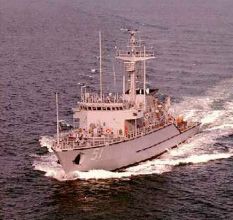 USS Osprey (MHC-51) | |
| History | |
|---|---|
| Name | USS Osprey |
| Namesake | osprey |
| Awarded | 22 May 1987 |
| Builder | Intermarine USA |
| Laid down | 16 June 1988 |
| Launched | 23 March 1991 |
| Acquired | 23 August 1993 |
| Commissioned | 20 November 1993 |
| Decommissioned | 15 June 2006 |
| Stricken | 15 June 2006 |
| Fate | Sold by U.S. General Services Administration for scrap, 08 May 2014 |
| Badge |  |
| General characteristics | |
| Class & type | Osprey-class coastal minehunter |
| Displacement | 817 tons (light) 904 tons (full) |
| Length | 188 ft (57 m) |
| Beam | 38 ft (12 m) |
| Draft | 11 ft (3.4 m) |
| Complement | 51 |
USS Osprey (MHC-51) is the lead ship of Osprey-class coastal mine hunters, and the fourth U.S. Navy ship of that name.